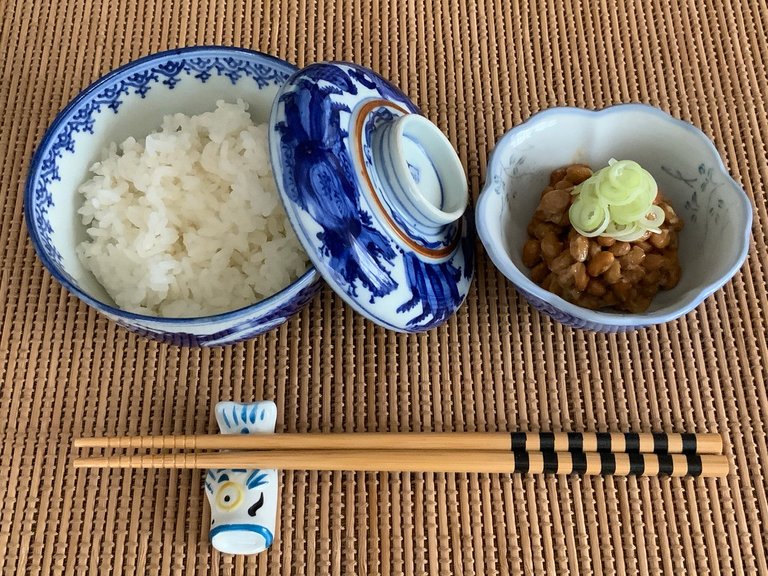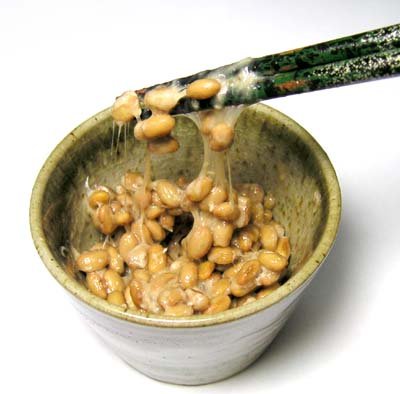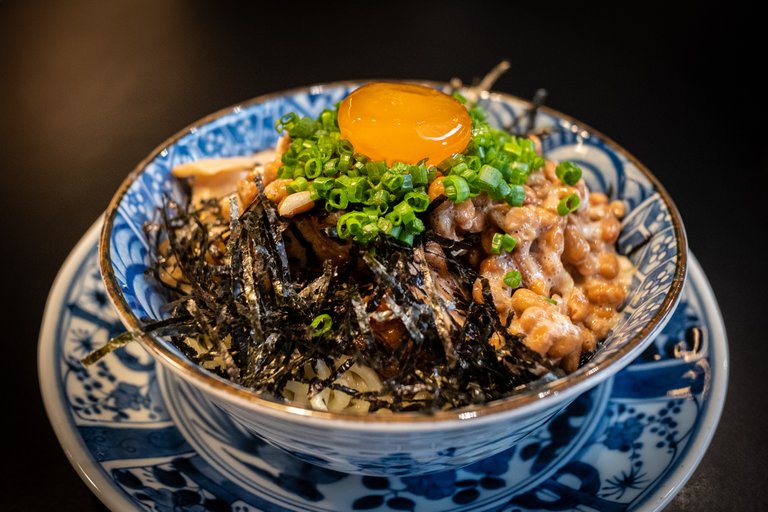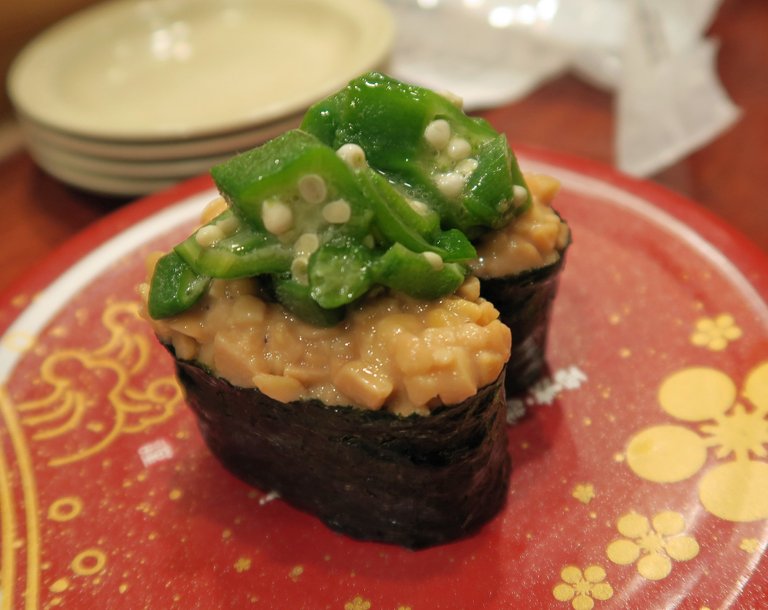Do you know nattō? If you've talked with me before you might have heard the word, but you probably don't know what it is.
This is nattō!

Image by 魔理沙 from Pixabay
Mmmm mouthwatering! I'm getting hungry just looking at that photo.
In today's post, let's talk about this beautiful food.

I first experienced nattō shortly after coming to Japan. One of my coworkers had mentioned it as something all foreigners should try. He didn't explain much more than that, simply saying I needed to mix it up until it was sticky and that I needed to try ASAP.
So I went to the store and picked me up some nattō. Mind you, I didn't know much Japanese at the time, and we didn't yet have smartphones to help identify things. But I was able to locate it without too much trouble at the supermarket.
I took it home, excited to try something new. I opened the package... oh my God—it stunk! Did I get a bad batch? No, it's suppose to be fermented, I reminded myself, so probably squishy and smelly. I mixed it up, tried it, and... decided I wouldn't have any more. haha. In fact, I downed a beer just to get the taste out of my mouth, even though it was only lunchtime.
Failure.

From Wikipedia
But I was stubborn. I knew it was healthy and it was very cheap and I knew the Japanese stereotype is that foreigners can't eat it and hate it, so I was determined to build up a taste. I started eating it everyday. At first I would mix it with all kind of things, including things like pasta sauce or kimchi or curry. I'd make nattō sandwiches and use honey to sweeten it enough that the taste didn't bother me. I also tried using peanut butter to mask the taste, and that was good.
Later I learned that this is far from uncommon among foreigners in Japan. Many foreigners loved sharing their crazy nattō mixtures and recipes. I was even at one point given a zine someone had made full of all kind of nattō ideas. I wish I still had that. It seemed like rather than be original in my quest to conquer nattō, I had just joined the throngs of foreigners who had had the same idea and who were also stubbornly trying to beat the stereotype.
Oh well. I guess none of us are as original as we think. At any rate, it all worked, and I began to not only enjoy nattō, but love it. I put all the crazy recipes aside and started eating it plain with my rice. Breakfast isn't complete without it!

Photo by 8-Low Ural on Unsplash
Nattō is fermented soybeans. It is quite healthy, having plenty of iron and manganese, about 50% of the copper and magnesium you need a day, large amounts of potassium, zinc, phosphorus, and selenium, vitamins B and C, and tons of vitamin K (over 500% the daily recommended amount) making it wonderful for people who are deficient in vitamin K. It has a bacteria that helps improve gut health, it has been shown in studies to improve bone density, it acts as a natural blood thinner and prevents plaque formation in the arteries, and it lowers blood pressure. In fact because of the last points, it is considered a super food for health health.
So yeah, nattō has a lot going for it. On the bad side, it stinks. Kind of like old moldy cheese. And it's sticky and squishy. I've long gotten used to the smell and don't mind it, and the texture never bothered me very much, but both of these things always stand in the way of people unfamiliar with it from trying.

Image by R I from Pixabay
I'd say it's definitely worth a try. But that's easy for me to say, because I love it. It's among the cheapest health food you will find, only costing about ¥50-¥100 for a three pack. That's about 36 cents to 72 cents at current exchange rates. I'm sure it costs more at Japanese grocery stores overseas, probably at least double, so the price might not be so good for you if you can find it, but it still is a good healthy food.
Anyway, if you have the chance, I suggest a try. You'll probably hate that first try, honestly, but then again maybe you won't. And if you keep trying it (you will get 3 tries if you buy a pack) you may just learn to love it.
Mmmm...nattō! (bonus: mix it with chopped up okra for double the stickyness!)

By Kirk K from Flickr
We can't have a praise of nattō without an ode! Let's ask ChatGPT!
Write me an ode to nattō, singing praise of the delicious food.
Oh Nattō, gift from nature’s larder,
Thy slippery strands, the joy and ardor.
Humble in appearance, mighty in might,
A Japanese delicacy that takes flight.
Born from soya, nurtured by Bacillus,
Your creation process truly does thrill us.
Though simple soybeans be your base,
Complex flavors in you, we can trace.
A paradox wrapped in a leaf's embrace,
Deftly merging health and taste.
Ancient tradition wrapped in tiny spheres,
Heralding the dawn, dispelling fears.
Eternal symbol of longevity,
Bestowed with unassuming brevity.
From Kanto to Kansai, you're the heart,
Of breakfasts that spur minds to start.
Upon a bowl of rice you perch,
A culinary temple, no need for a search.
Threads of viscous glory that extend,
In every bite, nutrition and joy blend.
Unassuming umami, a flavor profound,
In your tiny morsels, true delight is found.
Rich and earthy, your notes resonate,
A symphony of taste, you orchestrate.
Oh Nattō, you're more than a meal,
A cultural artifact, Japan's seal.
An embodiment of heritage, lore, and art,
Etching memories, a sensory chart.
A dose of probiotics, rich and potent,
A testament to nature's quotient.
Fermented wonder, in you we see,
The magic of transformation, the taste of glee.
Nattō, your essence is such,
A delicate balance, a tender touch.
A craft refined through centuries,
A testament to life's mysteries.
From mornings quiet to evenings dim,
Your presence, a comforting hymn.
Oh Nattō, in your praise we sing,
To your subtle magic, our tastebuds cling.
Though some may cringe, some may retreat,
The enlightened know, you're a treat.
Your power lies not in universal appeal,
But in depth of flavor, in the zeal.
Oh Nattō, your charm is quiet,
To your fans, a delicious diet.
We sing your praises, we stand in awe,
Your culinary sonnet without a flaw.
Your story carries on, from old to new,
Nattō, to you we bid adieu.
But worry not, for on the morrow,
We'll meet again, joy replacing sorrow.
😂😂😂 That may be the best thing I've read all week.
❦
 |
David LaSpina is an American photographer and translator lost in Japan, trying to capture the beauty of this country one photo at a time and searching for the perfect haiku. |